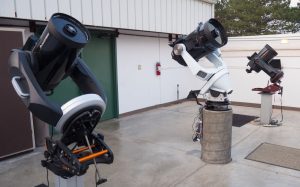The History of Hyde Observatory
This history is adapted from a paper written by Mark Dahmke and presented to the Lincoln Torch Club in 2013.
Hyde Observatory is located in Holmes Park, Lincoln, Nebraska. It was built in 1977. When it was founded, the observatory was the only facility in the U.S. built and operated entirely by donations, devoted exclusively to public viewing, completely free of charge and staffed only by volunteers. To this day, few other observatories meet all these criteria.
But there is more to the story, and that’s a journey into the history of Lincoln, and a story about a small group of amateur astronomers who founded the Prairie Astronomy Club.
The Prairie Astronomy Club can trace its beginnings back to November 7th, 1960, when the planet Mercury transited the sun. The event prompted an article in the newspaper, which mentioned that astronomy and physics professor Carroll Moore was going to observe the transit from Nebraska Wesleyan University.
This is the official version of the story, but the founding of the club has roots that go back much farther. One story comes from Rick Johnson, who became interested in astronomy in 1953. His father bought him a book on telescope making, but it included only three pages of complicated instructions. After several attempts, his father took him to meet Jess Williams. Jess owned an automotive shop at 22nd & “O” Street. Rick said that each time they’d go over there for help, he’d meet some of Jess’s friends, and that Jess had his own little astronomy club going. Jess would point out things for Rick to look at with his telescope, but there was no such thing as an organized astronomy club in Lincoln at that time.
Later, in 1956, when Rick’s parents were out of town on business, they hired a sitter, and that was Mrs. Frost, of Wells and Frost. She saw that he had an interest in astronomy, so she introduced Rick to Carroll Moore. Carroll asked Rick to add his name to a list of people interested in starting an astronomy club. Another charter member was Tom Pansing, an attorney. Pansing graduated from the UNL Law School in 1941 and was a partner in Crosby, Pansing & Guenzel. Rick said his father knew Tom, but they didn’t know of their common interest in astronomy until shortly before the first club meeting.
Carroll asked Pansing to write bylaws for a club and serve as its first president. Jess Williams and another amateur astronomer by the name of Dick Hartley joined, and the group started to have regular meetings. The club took shape in 1960 and 1961, and the first newsletter was printed in 1962. Pete Schultz, another of Rick’s classmates from Lincoln Southeast, was also a founder of the club and present at the first meeting.
According to Rick Johnson, Jess Williams and Tom Pansing tried to get a club started for many years, but Tom didn’t have the time. Then when Carroll Moore put together his list after the Mercury transit, he met with Jess, Tom and Dick Hartley to work out the club and its first officers. Apparently Dick and Carroll had been working together in parallel with Jess and Tom, but neither really knew of the other until Tom and Jess came to the Mercury transit.
Jess moved to Lincoln in 1900. In addition to operating an automotive spring business, he was a nationally known pianist famous for his ragtime performances, and there are stories about how people used to gather outside his shop to listen to him play.
In 1909 he met Scott Joplin when Joplin was in Lincoln, and that meeting influenced the rest of his life. Joplin joined the 17-year-old Williams and other members of the Lincoln Musicians’ Union for a jam session. He played in local bands during his student days, accompanied the silent movies at the Lyric, Majestic, and Sun theatres, was the calliope player for all the Masonic parades in Nebraska, and, at the age of 84, appeared in Washington, D. C. at the Smithsonian Institute’s Bicentennial Folklife Festival. Williams wrote more than 20 songs between 1920 and 1930. It is said that music was his whole life, but he also was passionate about astronomy. Rick said that kids flocked to Jess because of the old steam calliope, and Jess had his own kid’s astronomy club going prior to the Prairie Astronomy Club. No one could replace him for bringing in the kids.
Getting back to the astronomy club, in 1962, Pete Schultz noticed an ad for a “Moonlight Madness” sale at Gateway Mall. The only problem was there was a new moon at the scheduled time of the sale. Pete suggested that they contact Gateway with the idea that the club could setup some telescopes during the sale, and figured that Hartley as president was the one to do it. Dick on the other hand recognized Pete’s potential and turned the job over to him, much to his dismay. Pete had no car so Rick Johnson was the designated driver.
At that time Gateway was owned by Banker’s Life, now Ameritas, and they somehow managed to get in to talk with the board of directors. After making their pitch, the board not only agreed, but offered the club $100. Rick said that they weren’t even there to ask for money! And that was the start of the club’s public service.
Now a little bit of background on Pete Schultz. After graduating from Lincoln Southeast he got his B.A. from Carleton College in ‘66, and his Ph.D. in Astronomy at the University of Texas at Austin in ‘72. After working as a research associate at NASA Ames, and a Staff Scientist at The Lunar and Planetary Institute, he became an Associate Professor in the Department of Geological Sciences at Brown University in 1984 and was promoted to full Professor in ‘94.
He has done extensive research on cratering and was a principle researcher on NASA’s Deep Impact probe which impacted on Comet Tempel 1 in 2005 and the 2009 LCROSS probe which impacted on the Moon. He has also been interviewed for various science programs on the Discovery Channel, National Geographic and NOVA on PBS.
Sometime during those early years, Earl Moser joined the club. Earl owned an auto repair business in Hickman. He served as club president for many years and was one of the club’s most active and dedicated volunteers. In 1967 he helped acquire the club’s first telescope. It was a 12.5” Newtonian reflector on a heavy equatorial mount. The owner was willing to sell it for $800. Some of the money was raised through donations from club members, and the rest was financed through a small loan from a local bank.
The scope was used extensively at the club’s observing site, which was on Earl’s farm, and also saw a lot of use out at Gateway Mall and other events. The club hoped to find a permanent location for an observatory, but that goal was far in the future, so it was carried from place to place and mostly stored at Earl’s farm when not in use.
Someone came up with the idea that if the city would help build a small observatory, the club would donate the telescope.
Earl came to Lincoln and started scouting for a good dark sky location for an observatory. He said that Lincoln Public Schools was also interested in a community observatory, so he checked out sites near the schools, but none were suitable. He also checked Lincoln’s parks and found a nearly ideal location.
In the August, 1967 club newsletter it was reported that they’d found a site for the observatory. The telescope would be located in the south section of Holmes Park directly across from Cedars Home. Jess Williams and Tom Pansing contacted parks and recreation and they promised to help as much as possible, in regard to providing land and helping with the building.
An article in the Lincoln Journal stated that “Lincoln’s recreation program could be further diversified in the near future by the addition of a high-powered telescope and a facility to house it if plans can be worked out.” The Parks and Rec Board decided to investigate the matter, after a lengthy discussion of the availability of funds.
Tom Pansing was quoted as saying, “There really is a lot of interest in astronomy. At our last showing at Gateway Shopping Center, we had about 1500 people stop and look through the scopes.” He added that the club would operate the facility and give the lectures and shows for the Parks department. The Board agreed that the telescope would be a nice addition to recreational facilities.
However, it was pointed out that no capital improvement funds were available in that year’s budget to allow for construction of the $2,000 building in Holmes Park. Jim Ager said he would favor the proposal if the club could provide financing for the telescope shelter.
This proposal was ultimately turned down by Parks & Recreation due to a lack of funds. In a later club newsletter, Earl Moser proposed moving forward with a temporary observatory building or shed to house the club telescope, which was later built on his farm.
The club continued to haul the scope out to Gateway for public star parties. The remainder of the loan was paid off through additional donations and at one of the Gateway star parties the scope’s mortgage was burned by placing it at the telescope’s focus and pointing it at the sun.
The idea for a community observatory did not die, and was revived in the 1970s by Carroll Moore. He chaired several committee meetings that took place in 1974 and 1975. He began a fund drive to build a public observatory in time for the1976 bicentennial. One meeting was held in the Nebraska Union, and included Carroll Moore, Don Taylor of the UNL Physics Department, Jack Dunn from Mueller Planetarium, Dick Hilligas from City Parks, Dale Rathe from Lincoln Public Schools, John Gallagher from UNL and Esther Bennett from Chet Ager Nature Center.
The meeting was organized by Duane Hutchinson, who at that time was at Wesley House. Duane later became a storyteller and author, and is most famous for his ghost stories. Through 1974 and 75, the committee expanded to include representatives from·Southeast Community College, the Junior League of Lincoln and the Lincoln Foundation.
The planning committee set down a number of criteria for the observatory:
- That the building was to be used for public education and instruction in astronomy, rather than for research
- That the site was to be sufficiently far from the center of Lincoln that there would not be much light pollution
- That the location was to be close enough to the population to allow easy access, and maximum use.
- That the building allow a clear view of the skies from at least three permanently mounted telescopes, yet provide protection for the equipment when not in use.
- And that the building would accommodate groups of up to 50 people.
In June, 1976, Earl Moser reported that the committee had decided to delay plans for a general solicitation of businesses until late fall. There was concern about approaching businesses that were already being solicited for funds for other larger bicentennial projects. Approximately half of the required funds had been pledged or donated, and another $30,000 was needed to begin construction.
In July, it was reported that the design for the observatory had been finalized and would consist of a 12 x 30 foot observing deck with a roll-off roof, and three telescopes, including an 8-inch rich-field reflector, which would be built and donated by the club.
The less expensive roll-off roof idea came from Jack Dunn, who had been a student of Dr. Gilbert Lueninghoener, a professor of astronomy and geology at Midland Lutheran College in Fremont. Dr. Lueninghoener had built an observatory with a roll-off roof, and Jack suggested looking into this alternative design to hold down costs. Dr. Lueninghoener was also a cousin of Loren Eiseley, and while researching this paper, I ran across a death notice for Lueninghoener in The Caravan, a newsletter of the friends of Loren Eiseley, written by the late Naomi Brill.
It was decided to make a presentation to the Lincoln City Council to obtain city funding for the remainder of the proposed budget. The formal presentation was made by club member Lee Thomas who at that time was station and program manager for KLMS radio, and was later an associate professor of journalism at Doane College. It was noted that due to the Viking missions to Mars and the launch of the Voyager probes to Jupiter, there was an increased interest in astronomy and it was a good time to promote the observatory project.
In the August newsletter, it was reported that there was a good turnout of club members who helped to fill the City Council chambers to overflowing. Former Nebraska Governor Bob Crosby, Dale Rathe and Lee Thomas presented the case to the Council. The Observatory Committee had raised half of the $60,000 needed to complete the observatory, but the Council was in no mood to add money to anyone’s budget, and the proposal was dropped. The committee then realized that it should first have approached Mayor Helen Boosalis, to see if they could persuade her to add it to the budget.
By November, the committee was able to raise a total of $70,000 so the project could proceed without money from the city. A generous donation of $50,000 from Mrs. Flora Hyde, in memory of her late husband Leicester (pronounced “Lester”), completed the fundraising effort.
Leicester Hyde was an architect by profession and participated in the planning and development of many commercial, educational and community buildings. He was an officer of The Midwest Life Insurance Company for 18 years. He served as member of The Lincoln Foundation and a Trustee of the University of Nebraska Foundation and with his wife, funded the establishment of a chair in Architecture at the University of Nebraska.
Bids were let in February with construction to commence in March, 1977. The building would also include a meeting room, and the club would provide volunteers to operate the observatory on regular public observation nights. The Holmes Park site earlier surveyed by Earl Moser was selected, and the building was designed by Clark Enersen Partners.
Groundbreaking for Hyde Observatory occurred in April. In the May newsletter, club president Larry Stepp reported on construction progress. Framing was well underway, and he mentioned that the lights from the nearby baseball fields were not that much of a problem. The observatory has a feature that is probably unique in the city of Lincoln – it has a switch that can turn off all the street lights on either side of the observatory.
Larry also reported on the progress of the construction of the telescope that would be donated by the club. Larry, along with Ron Veys, built the scope’s mount and drive mechanism. Ron Veys joined the club in the early 70s while he was a student. He taught math and physics at Southeast Community College and is still a member of the club.
This is where I need to tell you more about Larry Stepp. Larry joined the club in 1965 and was an active club member when he was in high school and college. He graduated from UNL and then moved to Texas, where he worked for Texas Instruments. In 1985, he took a position in Tucson with the National Optical Astronomy Observatory, a division of the Association of Universities for Research in Astronomy, known as AURA.
While in Tucson, he worked on the design of two 8-meter telescopes, one on Mauna Kea in Hawaii, and the other in Chile. These two telescopes make up the Gemini Observatory. He stayed with the Gemini project as optics manager, and is now the Telescope Department Head on the Thirty Meter Telescope project. The telescope, currently in the planning stages, will consist of a segmented mirror made up of 492 hexagons, with 10 times the light collecting area of each of the Keck telescopes. Expected to cost about $1 billion, it will be the largest telescope in the world.
In August of 1977, Larry reported that the observatory was due to be completed in the first week of October, and that a contract was signed with NASA to provide for a solar heating system. He also reported that the Garden Club of Lincoln had agreed to provide the landscaping around the observatory.
Dedication was held on November 6th with remarks from Robert Northrop, Chairman of the Lincoln Foundation, Lulubel Emerson Pansing, member of the Lincoln Board of Education, Don Smith, Director of the Lincoln Parks & Recreation Department, and John Massey of the Marshall Space Flight Center. Mayor Helen Boosalis performed the ribbon cutting.
The opening of Hyde was unfortunately saddened by the passing of Jess Williams. In December Jess entered the hospital in Lincoln. The evening before his surgery he played piano for his fellow patients in the hospital lounge and the next day he died. Rick Johnson said that it was his trip to Washington in 1976, which included a command performance for President Ford that ultimately killed him. After that trip he was exhausted and never fully recovered. Even at age 83 when he played the piano, he played like a madman.
Back in the early, lean years of the club Jess practically was the Prairie Astronomy Club—at least he was the club’s spirit and vitality, and it was good that he’d lived to see the construction of an observatory that was bigger–and much better–than the one he’d originally worked for.
When it opened, Hyde Observatory became the focus for the club and its activities. The largest telescope at Hyde is the 14 inch Celestron. The second-largest instrument, acquired in 2005, is the 11 inch NexStar also made by Celestron. It replaced the original 8 inch reflector, which was on loan from Nebraska Wesleyan.
Hyde also has a rear-projection solar telescope designed and built by members of the club and funded by a $200 donation from the Junior League of Lincoln. The fully-enclosed optical system allows several people to safely view the surface of the sun at the same time. The solar telescope is used mainly for daytime school groups or for major events like solar eclipses and transits.
Once the observatory began operation, club membership increased to over sixty and the club moved its meetings to the observatory’s lecture room. The Gateway Shopping Center sky shows were discontinued, as members turned their attention to helping staff the observatory. Several club members served on the observatory’s board of directors to help guide observatory operations.
The February 1979 eclipse of the sun was viewed by over 500 visitors and covered on local television. The annular eclipse of 1985 was a record breaker for both Hyde and for the Astronomy Club, as over 500 visitors viewed the event. The year 1986 brought the return of Halley’s Comet, and with it, large crowds at the observatory. Club members brought their own telescopes and set up outside to help ease the extreme crowding in the observatory.
Comet Hyakutake put on a fine display in 1996 and in 2000 a total lunar eclipse brought out nearly 600 people. Again, the observatory provided a live television feed to local TV stations.
In 1977 Lee Thomas proposed the development of several multimedia slide shows for presentation at Hyde. With the help of Jack Dunn, Merton Sprengel and other club members, scripts were written for a series of programs on subjects such as the Moon, Meteor showers and the constellations. In 1981 the observatory received a mini-grant of $2000 in support of a project to create a series of four programs on the constellations. The project was funded through the Nebraska Committee for the Humanities. These and other slide shows were presented to visitors for over twenty years.
In December of 1996, Carroll Moore passed away at age 79. He is regarded as the father of both Hyde and the club, and in his honor there is now a memorial stone bench and plaque next to the main entrance of the observatory. In his remembrance Rick Johnson said: “Carroll picked up our botched idea for a public observatory and turned it into a reality. Carroll put together a team of people from all walks of life and before long, but not before one heck of a lot of work, Hyde Memorial Observatory was a reality.”
Carroll made it a full-time 80 hour a week effort. By making it a wide based effort it was far easier to attract the money needed, but that also meant it had to be on a bigger scale than what was originally envisioned by the club.
In a recent interview, Rick added, “As to Carroll’s public observatory it was really separate from what we’d tried. We’d given up on it, when he announced that he was taking a year’s leave from Wesleyan to work full-time on getting Lincoln a public observatory, if we were up to staffing it. Not many people would give up a year’s salary to take on a project like this.”
Because of the efforts of Carroll and the original Hyde committee and the volunteers who staff and operate the observatory, Lincoln has an asset that is probably unique in the world, and it has gone through many changes and improvements over the years. In 2003 the old solar heating system was replaced with a solar electric system that generates two kilowatts of power and supplies almost half of the power needed to operate the observatory.
In 1999 the observatory acquired a computer projector for the lecture room. The old slide programs were supplemented with various astronomy DVDs and NASA-produced programs.
In 2007, Jack Dunn and Mark Dahmke started converting the old constellation programs over to video by scanning the slides and digitizing the audio track. They also replaced the old computer with a more powerful system with a high definition graphics display. In 2009 Hyde bought a low light CCD video camera designed for use with telescopes. The camera can be inserted in place of an eyepiece, so views of planets and other bright objects can be displayed on the big screen in the lecture room.
When Hyde was built, that area of southeast Lincoln was not developed, so light pollution was not really a problem. In the past 30 years the city has grown around the observatory, and several issues have emerged. Most have been resolved to everyone’s satisfaction by working with developers; however a few problem lights remain.
On at least one occasion, it was suggested by a member of the city council that Hyde should move farther from town in search of darker skies. The possibility of encroachment by city lights was considered at the time the observatory was built, and it was decided that since the purpose of the observatory is to be a public facility, not a research facility, and therefore should be easily accessible, Hyde was to be located within the city limits.
One example often given is that of Griffith Observatory in Los Angeles. Even though in an area that is heavily light polluted, Griffith is a popular attraction, and easily fulfills its mission of education and entertainment, and to make science more accessible to the public.
We invite everyone to experience one of Lincoln’s hidden gems, or come to a meeting of the Prairie Astronomy Club, held at Hyde on the last Tuesday of each month.
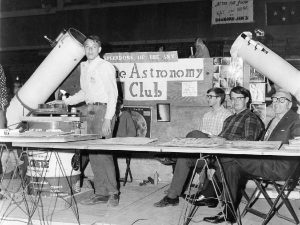
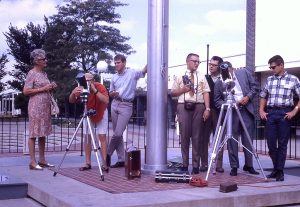
A “solar star party” at Gateway Mall in the 1960s.
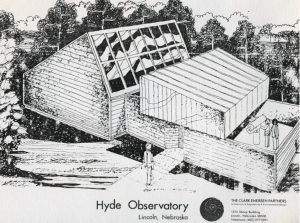
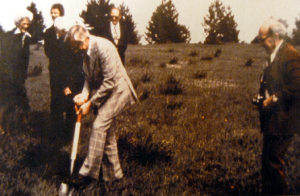
Groundbreaking at Holmes Park, 1977.
